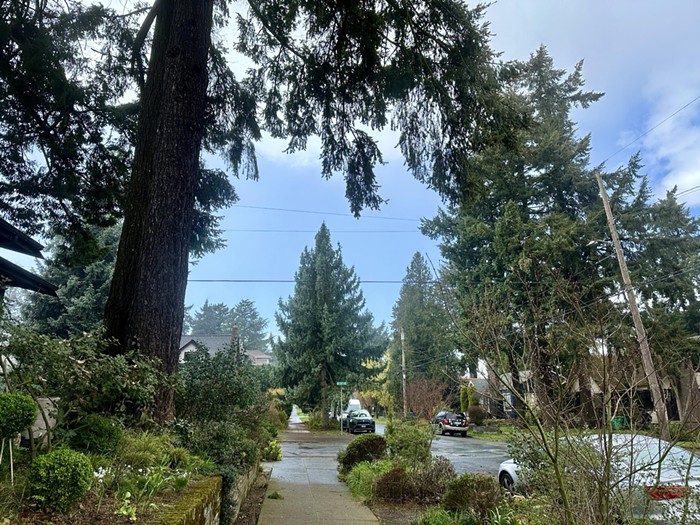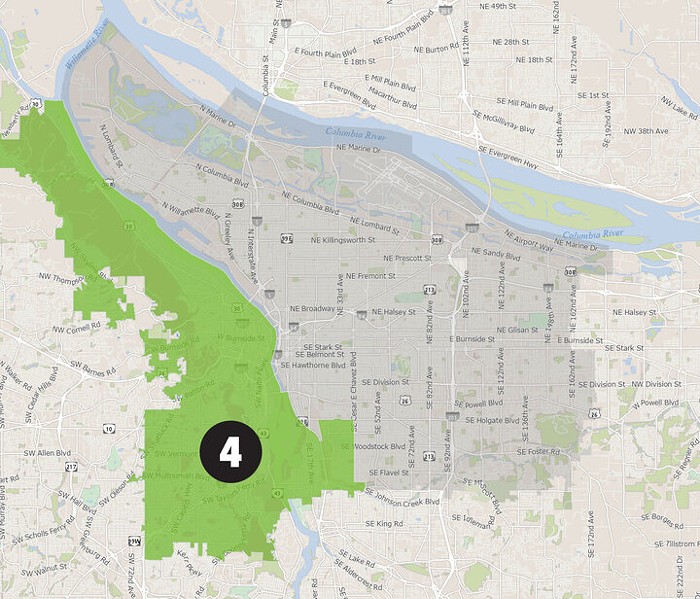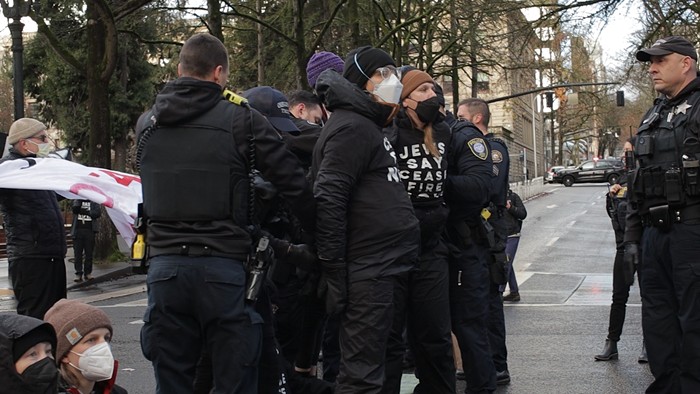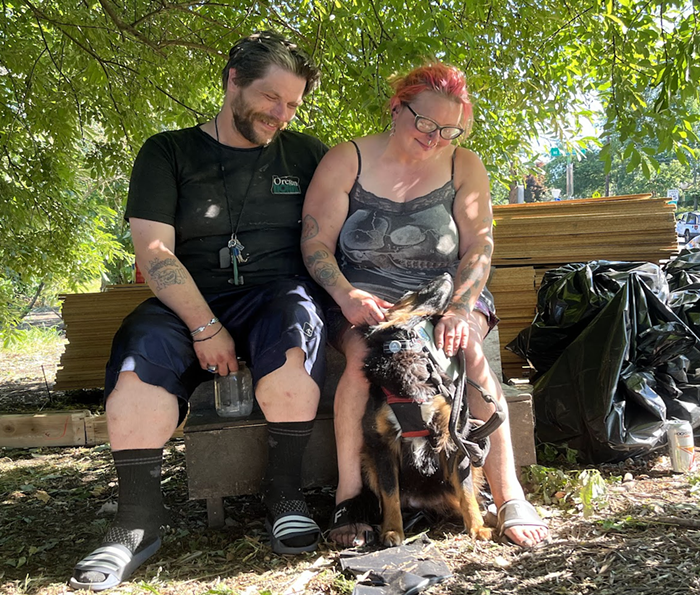It is arguably Portland's most controversial cop lawsuit ever. And even though it will be almost two years before a jury is scheduled to sit down and rule on the case, the pre-trial hearings are already heated, with both sides accusing the other of trying to prejudice a fair trial.
Civil rights attorney Tom Steenson, who is representing the family of James Philip Chasse Jr., won a record half-million dollar settlement against the city in a officer-involved lawsuit last Thursday, November 8, but appears to be pursuing this case with more than just a financial settlement in mind. The Chasse family, along with Steenson, all want sweeping changes in the way the police bureau operates.
James Chasse's father, James Sr., and his brother, Mark—both of whom bear a striking resemblance to photos of James Jr.—have sat patiently behind Steenson on the hardwood courtroom benches on the ninth floor of the Federal Justice Center downtown since the pre-trial hearings began in earnest earlier this year. Mark's jaw occasionally tightens listening to city attorneys make their arguments before Judge Dennis J. Hubel. His father's solid stoicism is unnerving, and both men bring a palpable pressure to the room.
WHAT HAPPENED?
The details of Chasse's death were shocking. Chasse, a 145-pound, 42-year-old schizophrenic, was spotted by police in the Pearl District urinating in the street on September 17, 2006. After a scuffle with police, Chasse died in a squad car being driven by these same officers.
The squad car was en route to Portland Adventist Hospital, 8.4 miles from the Multnomah County Detention Center (MCDC) on SW 3rd—not the Good Samaritan Hospital, 2.6 miles away from the jail, or the emergency room at OHSU, 2.1 miles from the jail.
It remains unclear why Chasse was confined to a holding cell for 23 minutes, and what happened there before a jail nurse looked through the window and noticed he was unconscious. Chasse had been medically cleared at the scene of his arrest earlier on NW 13th and Everett by a team of paramedics. However, an autopsy found extensive evidence of external and internal injuries when Chasse died—including 16 broken ribs, and abrasions and bruising all over his body.
Since his death, several people have come forward to file tort claims and lawsuits alleging they have been beaten by sheriff's deputies—and, occasionally, cops too—in holding cells and the booking area at MCDC, where James was held for 31 minutes before dying on his attempted transport to the Adventist Hospital ["Jail Guards Run Wild!" News, Sept 13]. The alleged beating of 40-year-old Michael Evans in the lobby of the jail was captured on video just six days before Chasse's time there, on September 11, 2006 ["Summary Injustice," News, July 19].
One of the officers involved in Chasse's death, Christopher Humphreys, was found to be the police bureau's second-highest user of force in statistics released last November. Humphreys also has "a history or pattern of falsifying police reports," according to attorney Steenson ["Death in the Public Interest," News, Oct 18], who says his office has evidence to support this allegation. Humphreys had been the subject of seven Internal Affairs Division complaints when the numbers were released, and has subsequently become the subject of another unrelated lawsuit. He still patrols for the police bureau.
THE PAPER TRAIL
Legally speaking, Steenson's pursuit of this case against the city is broader than in previous lawsuits he has filed, because this time he's asked for more documents. Fittingly enough, these documents have become a huge source of contention between the two parties.
"The plaintiffs are asking for all the underlying documents for things that happened years ago in the police department," said Deputy City Attorney Jim Rice in court last Wednesday, November 7. "Tracking this down takes an inordinate amount of time."
Indeed, Steenson is not only asking for documents directly associated with Chasse's death—which include officer disciplinary records and a copy of the police bureau's (still incomplete) internal affairs investigation into the incident—but police files on officer-involved deaths dating back to the 1980s, copies of external reports on those deaths along with the supporting documentation gathered to produce those reports, not to mention reams of training documents and other supporting information.
At issue for Steenson and the Chasse family is that the police bureau could not only have prevented Chasse's death, but the bureau's lack of adequate training and disciplinary procedure directly contributed to his demise. They want to prove that the City of Portland has Chasse's blood on its hands.
The Chasse family gave the police bureau a two-page list of things it wants to see changed after filing the lawsuit on February 14 this year, including: Implementing a more effective early warning system to better deal with officers using high rates of force, and making the city's so-called Independent Police Review truly independent by having investigations conducted by independent attorneys, rather than internal affairs detectives. ("It's kind of like leaving the fox in charge of the henhouse," said Steenson.)
Further recommendations are: Changing the bureau's written policy on mental illness to include an anti-discrimination clause; changing the bureau's foot pursuit policy to prohibit taking innocent citizens to the ground unless officers have probable cause to believe the suspect is highly dangerous; changing the bureau's policy on officers using hands and feet to make impact strikes to a person's vital areas; and raising the burden of proof on an officer using deadly force from a "reasonable belief" that a suspect is dangerous, to "probable cause" that they pose an imminent risk of death or serious bodily injury.
So far, the police bureau and the city have implemented none of those changes. However officers are now required to obtain paramedics' permission to take someone in Chasse's situation to a hospital from MCDC, as well as inform paramedics on how much force was used.
In October 2006, Mayor Tom Potter mandated 40 hours of widely touted crisis intervention training for all officers, 25 percent of whom are now trained, but an urgently needed 16-bed crisis triage center—somewhere for officers to take mentally ill people in crisis—appears to be slipping further down the county's list of funding priorities with each passing month ["Less Than a Crisis?" News, Nov 1].
ALL THE TIME IN THE WORLD
Steenson has been frustrated by the city's failure, so far, to produce any of the documents he's asked for—despite Judge Hubel's order on October 16 for the city to complete discovery by three weeks ago, on Friday, October 26.
"I've seriously considered filing a motion for contempt," said Steenson in court last Wednesday, November 7, protesting against the city's failure to comply with the judge's order.
"We're not trying to slough it off," replied Deputy City Attorney Rice. "It's just a lot of information."
Rice said he now thinks the city might be able to produce the documents to Steenson by the end of November, beginning on November 16. Despite having only one other attorney, David Landrum, and one paralegal supervisor, Cheryl Noll, working on the case, Rice argued the city is doing its best to comply with Steenson's request for production of the documents.
"The increased complexity of litigation requires enormous efforts," Rice said. "We don't have another place for a paralegal physically in the building—we have taken closets and put lawyers in them."
Steenson responded by saying, with respect, that he had "no reason to believe what they are saying to the court."
A FAIR TRIAL
The longer the city waits to produce necessary documents in this case, the less time experts retained by Steenson have to review those documents before the pre-trial moves to its next stage, depositions, in January.
The city, too, has raised questions about whether it is possible to try this case fairly, arguing newspaper journalists and TV reporters are prejudicing the public's viewpoint. In the past, when the city has been involved in, or settled, cop lawsuits, it has always bought silence from the victims' families with a so-called "protective order," preventing public release of sensitive documents both during and after the trial.
Chief Rosie Sizer and Mayor Potter have spoken often about wanting the police bureau to be more transparent ["Chief Concerns," Feature, Jan 18] but such protective orders make it impossible for the public to have a thorough, evidence-based discussion about what might be wrong with the Portland Police Bureau.
That's why a conglomerate of local media including the Portland Tribune, the Oregonian, and all of the city's TV stations hired attorney firm Davis Wright Tremaine to intervene as a third party in the case on October 10—arguing that a protective order should not cover the city's production of documents in this case.
The city objected to the intervention on the grounds of officer safety—delivering an affidavit from Officer Humphreys saying he has been stalked in the past by an "armed individual." But in a counter-argument, Steenson said in writing on November 2 that "the potential consequences of shielding these documents from the public eye should not be underestimated, particularly where one of those consequences could be the more unnecessary and tragic deaths of innocent citizens."
"I think something that hasn't been spoken to is the issue of citizen safety," Steenson said, arguing in court this past Tuesday, November 13. "The public airing of Chasse's death and some of its follow-up has had a profound effect on some people in the city."
Regardless of its outcome, the public will most likely maintain a high level of interest in the outcome of the Chasse case—which will have far reaching consequences for Portland and the way it is policed.
The case continues.


















